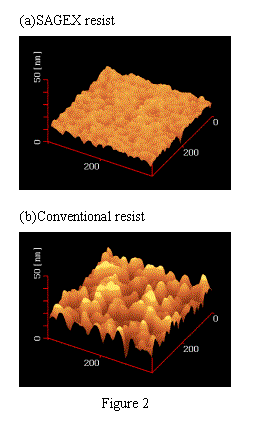

Cross-linked resist for small line-edge roughness
We have clarified that line-edge roughness is due to polymer aggregates 20-30 nm in size, which are contained in resist materials [1]. In resist films containing theses aggregates, the polymers surrounding aggregates dissolve faster and the aggregates can be extracted from the resist surface one by one since the polymer density is higher inside the aggregates (the aggregate extraction development [2]). As a result, many aggregates remain embedded on the pattern sidewall and they are responsible for pattern roughness [Fig. 1(a)].
To reduce roughness, aggregate extraction development must be suppressed. To achieve this, we have developed SAGEX resist (suppressed aggregate extraction development resist) [3]. In SAGEX resist, the polymer aggregates are thermally cross-linked with each other before electron-beam exposure. In the exposed regions, the resist dissolves uniformly over the whole surface since cross-linking slows down the dissolution rate of the surrounding polymers to the point where it is the same as that of the aggregates themselves. As a result, the aggregate extraction development is suppressed and the resulting patterns have smaller roughness. Figure 2 shows surface roughness on the exposed region observed by an atomic force microscope (AFM). In conventional resists, the surface becomes rougher because of the appearance of the aggregates on the surface. In contrast, in SAGEX resists, no aggregates can be observed and the surface roughness is drastically reduced to less than one-third compared to that with conventional resist film. This proves that the aggregate extraction development is actually suppressed in SAGEX resist. These results show that SAGEX resist is very effective for nanodevice fabrication.
[1] T. Yamaguchi, et al., Appl. Phys. Lett. 71(1997) 2388-2390.
H. Namatsu, et al., J. Vac. Sci. Technol. B16 (1998) 69-76.
H. Namatsu, et al., J. Vac. Sci. Technol. B16 (1998) 3315-3321.
[2] T. Yamaguchi, et al., Proc. SPIE 3333 (1998) 830-836.
[3] T. Yamaguchi, et al., Jpn. J. Appl. Phys. 38 (1999) 7114-7118.
 |
 |
||